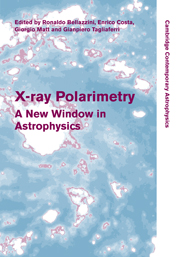Book contents
- Frontmatter
- Contents
- List of contributors
- Preface
- 1 X-ray polarimetry: historical remarks and other considerations
- Part I Polarimetry techniques
- Part II Polarized emission in X-ray sources
- 14 Probing strong gravity effects with X-ray polarimetry
- 15 X-ray polarization from black holes in the thermal state
- 16 Strong-gravity effects acting on polarization from orbiting spots
- 17 Polarization of thermal emission from accreting black holes
- 18 X-ray polarimetry and radio-quiet AGN
- 19 The soft X-ray polarization in obscured AGN
- 20 The polarization of complex X-ray sources
- 21 Polarization of Compton X-rays from jets in AGN
- 22 Polarization of X-ray lines from galaxy clusters and elliptical galaxies
- 23 Polarization characteristics of rotation-powered pulsars
- 24 Polarized X-rays from magnetized neutron stars
- 25 Polarization properties of X-ray millisecond pulsars
- 26 X-ray polarization signatures of neutron stars
- 27 Polarization from the oscillating magnetized accretion torus
- 28 X-ray polarization from accreting white dwarfs and associated systems
- 29 Polarization of pulsar wind nebulae
- 30 X-ray polarization of gamma-ray bursts
- 31 Central engine afterglow from GRBs and the polarization signature
- 32 GRB afterglow polarimetry past, present and future
- 33 Gamma-ray polarimetry with SPI
- 34 INTEGRAL/IBIS observations of the Crab nebula and GRB 041219A polarization
- 35 Fermi results on the origin of high-energy emission in pulsars
- 36 Diagnostics of the evolution of spiral galaxies in a cluster environment
- Part III Future missions
- Author index
- Subject index
17 - Polarization of thermal emission from accreting black holes
from Part II - Polarized emission in X-ray sources
Published online by Cambridge University Press: 06 July 2010
- Frontmatter
- Contents
- List of contributors
- Preface
- 1 X-ray polarimetry: historical remarks and other considerations
- Part I Polarimetry techniques
- Part II Polarized emission in X-ray sources
- 14 Probing strong gravity effects with X-ray polarimetry
- 15 X-ray polarization from black holes in the thermal state
- 16 Strong-gravity effects acting on polarization from orbiting spots
- 17 Polarization of thermal emission from accreting black holes
- 18 X-ray polarimetry and radio-quiet AGN
- 19 The soft X-ray polarization in obscured AGN
- 20 The polarization of complex X-ray sources
- 21 Polarization of Compton X-rays from jets in AGN
- 22 Polarization of X-ray lines from galaxy clusters and elliptical galaxies
- 23 Polarization characteristics of rotation-powered pulsars
- 24 Polarized X-rays from magnetized neutron stars
- 25 Polarization properties of X-ray millisecond pulsars
- 26 X-ray polarization signatures of neutron stars
- 27 Polarization from the oscillating magnetized accretion torus
- 28 X-ray polarization from accreting white dwarfs and associated systems
- 29 Polarization of pulsar wind nebulae
- 30 X-ray polarization of gamma-ray bursts
- 31 Central engine afterglow from GRBs and the polarization signature
- 32 GRB afterglow polarimetry past, present and future
- 33 Gamma-ray polarimetry with SPI
- 34 INTEGRAL/IBIS observations of the Crab nebula and GRB 041219A polarization
- 35 Fermi results on the origin of high-energy emission in pulsars
- 36 Diagnostics of the evolution of spiral galaxies in a cluster environment
- Part III Future missions
- Author index
- Subject index
Summary
Multicolour black-body emission from the accretion disc around the black hole can be polarized on its way through the atmosphere above the accretion disc. We model this effect by assuming Kerr metric for the black hole, a standard thin disc for the accretion flow and Thomson scattering in the atmosphere. We compute the expected polarization degree and the angle as they can be measured for different inclinations of the observer, optical thickness of the atmosphere and different values of the black hole spin. All relativistic effects near a compact centre are taken into account. We also assess the perspectives for the next generation of X-ray polarimeters.
Introduction
We consider polarization originating from a Keplerian, geometrically thin and optically thick accretion disc near a black hole. At each radius the accretion disc emits black body radiation, the temperature of which is given by the Novikov-Thorne expression for the outer part of the standard disc. The thermal photons are scattered in the atmosphere of the disc and thus the observed radiation becomes polarized. We assume multiple Thomson scattering with different optical depths of the disc atmosphere. The effect of hardening of the energy of photons due to scattering is taken into account via the hardening factor that increases the effective temperature.
Once the photons leave the atmosphere the polarization vector can be rotated due to strong gravity of the black hole. The energy of photons is shifted by the gravitational and Doppler effects.
- Type
- Chapter
- Information
- X-ray PolarimetryA New Window in Astrophysics, pp. 117 - 121Publisher: Cambridge University PressPrint publication year: 2010

